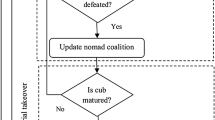Abstract
Nowadays, a great deal of attention is paid to metaheuristic algorithms to reach the approximate solution in an acceptable computational time. As one of the recent-developed successful metaheuristics, Social Engineering Optimizer (SEO) algorithm is according to the inspiration of the rules of social engineering to solve approximate optimization problems. In this research, a Modified Social Engineering Optimizer algorithm (MSEO) by using an adjustment operator is proposed in which there are some assessment criteria for defender and attacker to determine and calculate the weight simultaneously for the first time. This enhancement comprises adding adjustment operators to improve the performance of SEO in terms of search accuracy and running time. Most notably, this operator is utilized to make a better new generation and improve the interaction between the search phases. The adjustment operator strategy is also applied to a novel division based on the best person. As an extensive comparison, the suggested algorithm is tested on fourteen standard benchmark functions and compared with ten well-established and recent optimization algorithms as well as the main version of the SEO algorithm. This algorithm is also tested for sensitivities on the parameters. In this regard, a set of engineering applications were provided to prove and validate the MSEO algorithm for the first time. The experimental outcomes show that the suggested algorithm produces very accurate results which are better than the SEO and other compared algorithms. Most notably, the MSEO provides a very competitive output and a high convergence rate.






















Similar content being viewed by others
Data availability
Enquiries about data availability should be directed to the authors.
References
Abed-Alguni BH, Alawad NA (2021) Distributed Grey Wolf Optimizer for scheduling of workflow applications in cloud environments. Appl Soft Comput 102:107113
Abed-Alguni BH, Alawad NA, Barhoush M, Hammad R (2021) Exploratory cuckoo search for solving single-objective optimization problems. Soft Comput 25(15):10167–10180
Abed-Alguni BH, Alkhateeb F (2017) Novel selection schemes for cuckoo search. Arab J Sci Eng 42(8):3635–3654
Abualigah LMQ (2019) Feature selection and enhanced krill herd algorithm for text document clustering. Springer, Berlin, pp 1–165
Abualigah L, Yousri D, Abd Elaziz M, Ewees AA, Al-Qaness MA, Gandomi AH (2021a) Aquila optimizer: a novel meta-heuristic optimization Algorithm. Comput Ind Eng 157:107250
Abualigah L, Diabat A, Mirjalili S, Abd Elaziz M, Gandomi AH (2021b) The arithmetic optimization algorithm. Comput Methods Appl Mech Eng 376:113609
Alawad NA, Abed-Alguni BH (2021a) Discrete Jaya with refraction learning and three mutation methods for the permutation flow shop scheduling problem. J Supercomput 1–22
Alawad NA, Abed-Alguni BH (2021b) Discrete island-based cuckoo search with highly disruptive polynomial mutation and opposition-based learning strategy for scheduling of workflow applications in cloud environments. Arab J Sci Eng 46(4):3213–3233
Aslan S (2019) A transition control mechanism for artificial bee colony (ABC) algorithm. Comput Intell Neurosci. https://doi.org/10.1155/2019/5012313
Balaji AN, Porselvi S, Jawahar N (2019) Particle swarm optimization algorithm and multi-start simulated annealing algorithm for scheduling batches of parts in multi-cell flexible manufacturing system. Int J Serv Oper Manag 32(1):83–129
Bottani E, Murino T, Schiavo M, Akkerman R (2020) Resilient food supply chain design: modelling framework and metaheuristic solution approach. Comput Ind Eng 157:274–289
Castellani M, Otri S, Pham DT (2019) Printed circuit board assembly time minimization using a novel Bees algorithm. Comput Ind Eng 133:186–194
Dhiman G, Kaur A (2019) STOA: a bio-inspired based optimization algorithm for industrial engineering problems. Eng Appl Artif Intell 82:148–174
Elarbi S, Bechikh A, Gupta LB, Said YS (2018) Ong, a new decomposition-based NSGA-II for many-objective optimization. IEEE Trans Syst, Man, Cybern: Syst 48(7):1191–1210
Fakhrzad MB, Goodarzian F (2019) A fuzzy multi-objective programming approach to develop a green closed-loop supply chain network design problem under uncertainty: modifications of imperialist competitive algorithm. RAIRO-Oper Res 53(3):963–990
Fathollahi-Fard AM, Hajiaghaei-Keshteli M, Tavakkoli-Moghaddam R (2018) The social engineering optimizer (SEO). Eng Appl Artif Intell 72:267–293
Fathollahi-Fard AM, Ranjbar-Bourani M, Cheikhrouhou N, Hajiaghaei-Keshteli M (2019) Novel modifications of social engineering optimizer to solve a truck scheduling problem in a cross-docking system. Comput Ind Eng 137:106103
Geem ZW, Kim JH, Loganathan GV (2001) A new heuristic optimization algorithm: harmony search. SIMULATION 76(2):60–68
Ghasemi P, Khalili-Damghani K, Hafezalkotob A, Raissi S (2019) Uncertain multi-objective multi-commodity multi-period multi-vehicle location-allocation model for earthquake evacuation planning. Appl Math Comput 350:105–132
Glover F (1989) Tabu search—part I. ORSA. J Comput 1(3):190–206
Goli A, Tirkolaee EB, Malmir B, Bian GB, Sangaiah AK (2019) A multi-objective invasive weed optimization algorithm for robust aggregate production planning under uncertain seasonal demand. Computing 101(6):499–529
Goodarzian F, Hosseini-Nasab H, Muñuzuri J, Fakhrzad MB (2020) A multi-objective pharmaceutical supply chain network based on a robust fuzzy model: a comparison of meta-heuristics. Appl Soft Comput 92:106331
Goodarzian F, Kumar V, Abraham A (2021a) Hybrid meta-heuristic algorithms for a supply chain network considering different carbon emission regulations using big data characteristics. Soft Comput 25(11):7527–7557
Goodarzian F, Kumar V, Ghasemi P (2021b) “A set of efficient heuristics and meta-heuristics to solve a multi-objective pharmaceutical supply chain network. Comput Ind Eng 158:107389
Goodarzian F, Abraham A, Fathollahi-Fard AM (2021c) A biobjective home health care logistics considering the working time and route balancing: a self-adaptive social engineering optimizer. J Comput Des Eng 8(1):452–474
Goodarzian F, Ghasemi P, Gunasekaren A, Taleizadeh AA, Abraham A (2021d) A sustainable-resilience healthcare network for handling COVID-19 pandemic. Ann Oper Res. https://doi.org/10.1007/s10479-021-04238-2
Goodarzian F, Taleizadeh AA, Ghasemi P, Abraham A (2021e) An integrated sustainable medical supply chain network during COVID-19. Eng Appl Artif Intell 100:104188
Goudarzi S, Anisi MH, Abdullah AH, Lloret J, Soleymani SA, Hassan WH (2019) A hybrid intelligent model for network selection in the industrial internet of things. Appl Soft Comput 74:529–546
Hajipour V, Tavana M, Di Caprio D, Akhgar M, Jabbari Y (2020) An optimization model for traceable closed-loop supply chain networks. Appl Math Model 84:265–279
Kamaruddin S, Latif MAHA (2019) Application of the bees algorithm for constrained mechanical design optimization problem. Int J Eng Mater Manuf 4(1):27–32
Karaboga D, Basturk B (2007) Artificial bee colony (ABC) optimization algorithm for solving constrained optimization problems. In: International fuzzy systems association world congress, pp 789–798. Springer, Berlin, Heidelberg
Kennedy J, Eberhart R (1995) Particle swarm optimization (PSO). In: Proc. IEEE international conference on neural networks, Perth, Australia, pp 1942–1948
Lei D, Li M, Wang L (2018) A two-phase meta-heuristic for multi-objective flexible job shop scheduling problem with total energy consumption threshold. IEEE Trans Cybern 49(3):1097–1109
Li J, Zhang JQ, Jiang CJ, Zhou MC (2015) Composite particle swarm optimizer with historical memory for function optimization. IEEE Trans Cybern 45(10):2350–2363
Luan J, Yao Z, Zhao F, Song X (2019) A novel method to solve supplier selection problem: hybrid algorithm of genetic algorithm and ant colony optimization. Math Comput Simul 156:294–309
Meng X, Li J, Zhou M, Dai X, Dou J (2016) Population-based incremental learning algorithm for a serial colored traveling salesman problem. IEEE Trans Syst, Man, Cybern: Syst 48(2):277–288
Mitchell M, Forrest S, Holland JH (1992) The royal road for genetic algorithms: fitness landscapes and GA performance. In: Proceedings of the 1st European conference on artificial life, pp 245–254
Nazari-Shirkouhi S, Eivazy H, Ghodsi R, Rezaie K, Atashpaz-Gargari E (2010) Solving the integrated product mix-outsourcing problem using the imperialist competitive algorithm. Expert Syst Appl 37(12):7615–7626
Okulewicz M, Mańdziuk J (2019) A metaheuristic approach to solve dynamic vehicle routing problem in continuous search space. Swarm Evol Comput 109:236–245
Pech S, Kandler G, Lukacevic M, Füssl J (2019) Metamodel assisted optimization of glued laminated timber beams by using metaheuristic algorithms. Eng Appl Artif Intell 79:129–141
Pham DT, Ghanbarzadeh A, Koc E, Otri S, Rahim S, Zaidi M (2005) The bee's algorithm. Technical note, Manufacturing Engineering Centre, Cardiff University, UK
Rakshit P, Konar A, Das S, Jain LC, Nagar AK (2014) Uncertainty management in differential evolution induced multi-objective optimization in presence of measurement noise. IEEE Trans Syst, Man, Cybern: Syst 44(7):922–937
Ramírez A, Romero JR, García-Martínez C, Ventura S (2019) JCLEC-MO: a Java suite for solving many-objective optimization engineering problems. Eng Appl Artif Intell 81:14–28
Sacramento D, Pisinger D, Ropke S (2019) An adaptive large neighborhood search metaheuristic for the vehicle routing problem with drones. Transp Res Part c: Emerging Technol 102:289–315
Shadravan S, Naji HR, Bardsiri VK (2019) The Sailfish Optimizer: a novel nature-inspired metaheuristic algorithm for solving constrained engineering optimization problems. Eng Appl Artif Intell 80:20–34
Shang Y, Nguyen H, Bui XN, Tran QH, Moayedi H (2020) A novel artificial intelligence approach to predict blast-induced ground vibration in open-pit mines based on the firefly algorithm and artificial neural network. Nat Resour Res 29(2):723–737
Simon D (2008) Biogeography-based optimization. IEEE Trans Evol Comput 12(6):702–713
Stützle T, Dorigo M (1999) A CO algorithms for the traveling salesman problem. Evol Algor Eng Comput Sci 4:163–183
Tam JH, Ong ZC, Ismail Z, Ang BC, Khoo SY (2019) A new hybrid GA−ACO−PSO algorithm for solving various engineering design problems. Int J Comput Math 96(5):883–919
Wang K, Luo H, Liu F, Yue X (2018) Permutation flow shop scheduling with batch delivery to multiple customers in supply chains. IEEE Trans Syst, Man, Cybern: Syst 48(10):1826–1837
Yadegari E, Alem-Tabriz A, Zandieh M (2019) A memetic algorithm with a novel neighbourhood search and modified solution representation for closed-loop supply chain network design. Comput Ind Eng 128:418–436
Yang XS (2010) Firefly algorithm, Levy flights and global optimization. In: Research and development in intelligent systems, vol XXVI, pp 209–218. Springer, London
Yi J, Gao L, Li X, Shoemaker CA, Lu C (2019) An on-line variable-fidelity surrogate-assisted harmony search algorithm with multi-level screening strategy for expensive engineering design optimization. Knowl-Based Syst 170:1–19
Zhang X, Du KJ, Zhan ZH, Kwong S, Gu TL, Zhang J (2020) Cooperative coevolutionary bare-bones particle swarm optimization with function independent decomposition for large-scale supply chain network design with uncertainties. IEEE Trans Cybern. https://doi.org/10.1109/TCYB.2019.2937565
Acknowledgements
This research has been financially supported by The Analytical Center for the Government of the Russian Federation (Agreement No. 70-2021-00143 dd. 01.11.2021, IGK000000D730321P5Q0002).
Funding
The authors have not disclosed any funding.
Author information
Authors and Affiliations
Corresponding author
Ethics declarations
Conflict of interest
The authors declare that they have no conflict of interest.
Human and animal rights
This article does not contain any studies with human or animal subjects performed by any of the authors.
Informed consent
Informed consent was not required as no humans or animals were involved.
Additional information
Publisher's Note
Springer Nature remains neutral with regard to jurisdictional claims in published maps and institutional affiliations.
Rights and permissions
About this article
Cite this article
Goodarzian, F., Ghasemi, P., Kumar, V. et al. A new modified social engineering optimizer algorithm for engineering applications. Soft Comput 26, 4333–4361 (2022). https://doi.org/10.1007/s00500-022-06837-y
Accepted:
Published:
Issue Date:
DOI: https://doi.org/10.1007/s00500-022-06837-y




